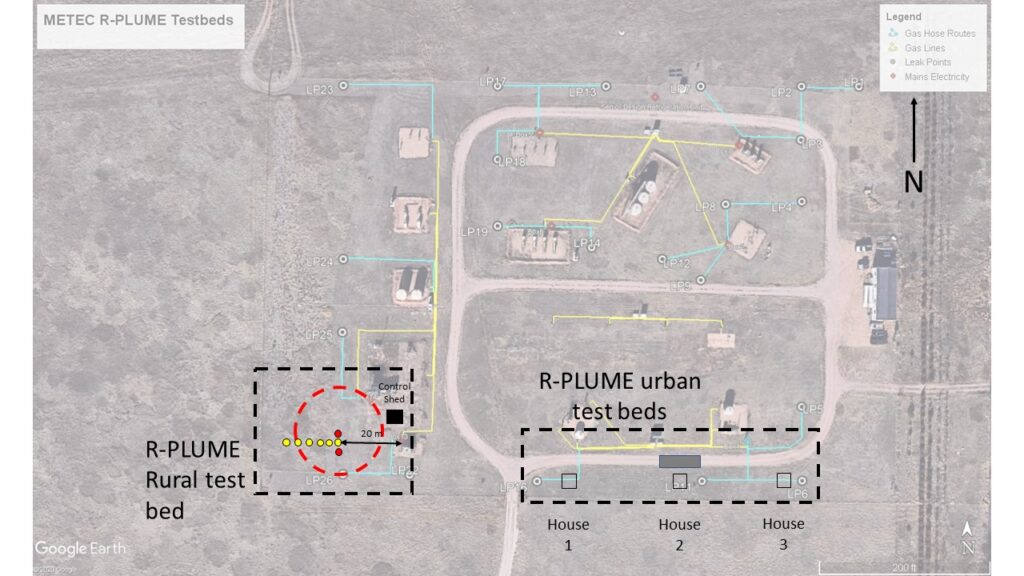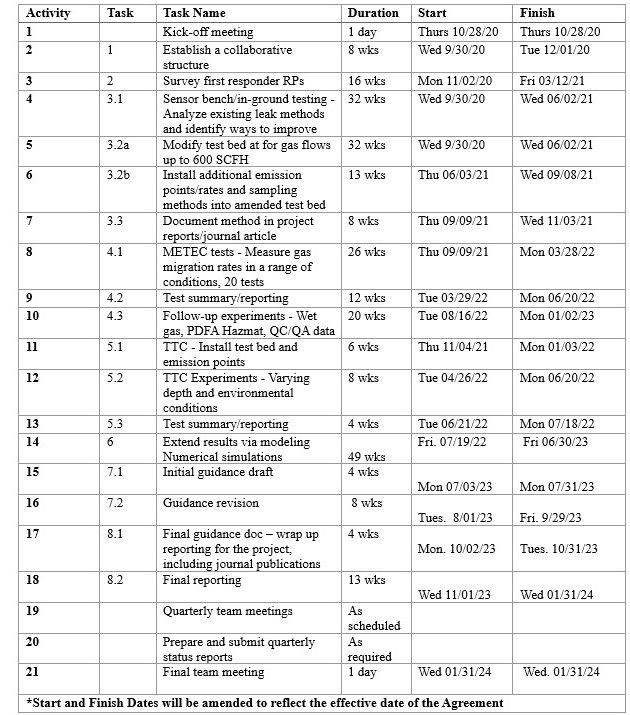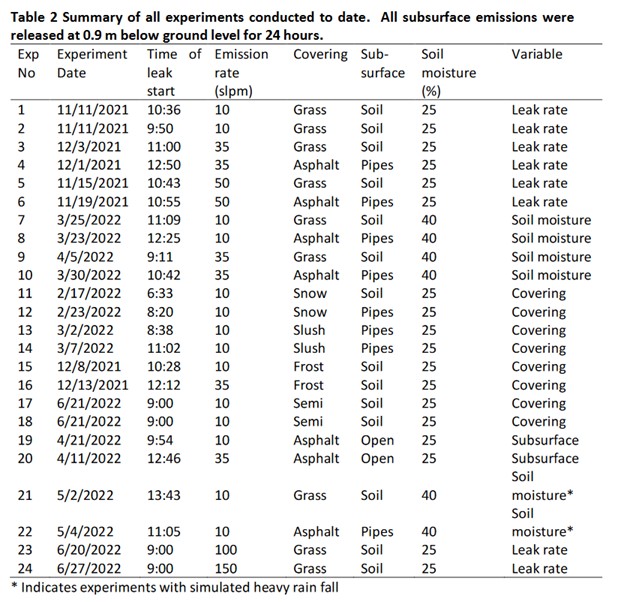Response Protocol for Large Underground Methane Emissions (R-PLUME)


Summary:
Project Title: Validating Models for Predicting Gas Migration and Mitigating its Occurrence/Consequence
Colorado State University and the Southern Methodist University (SMU) are working on a major project to better understand gas migration from moderate-to-large underground leaks, validating models to understand those leaks, and developing methods to assess and respond to these leaks. Underground natural gas pipeline leakage, especially at moderate to high flow rates, can result in gas migration and buildup, producing explosive concentrations within nearby substructures. A critical knowledge gap is knowing how environmental conditions affect gas migration behavior in these scenarios, and how emergency first responders can factor them into decision making. As part of the project, we review historical incident reports from PHMSA and identify if conclusions drawn from our field measurements could have prevented the incident. This project addresses PHMSA’s request for high resolution field tests for model validation by using novel above/below ground sensors to characterize gas migration speed and distance at high leakage rates and concentrations above explosive limits. This work will:
- Advance methods to characterize significant natural gas leaks from buried pipelines,
- Advance leak detection and repair methods for pipeline leaks, especially large leak scenarios,
- Deliver an empirical understanding of large leak behavior that can be incorporated into first responder and leak detection protocols.
Colorado State University and the Southern Methodist University are collaborating with industry and first responder partners, who serve as members on a technical advisory panel, provide access to their response protocols, and, in some cases, participate in field testing. Controlled field testing is performed at CSU’s Methane Emission Technology Evaluation Center.
Objectives:
The project will focus on underground natural gas (NG) leaks with moderate to high flow rates (>100 scfh) that can produce explosive concentrations nearby. Proposed work will advance the understanding of gas migration behavior and provide decision guidance for stakeholders by:
- Making direct measurements of gas migration speed and extent at the surface, and in the subsurface, in a range of environmental conditions.
- Pairing measurements with models to extend knowledge beyond measurable scenarios.
- Linking gas concentration measurements with observations of environmental conditions to estimate extent a
Project Plan:
1. Determine collaborative study structure. Results due to PHMSA within three (3) months of the effective date of the Agreement.
2. Survey existing first responders’ operational practices. Summary of current RPs from TAP members and other contributors. Guidance for improving RPs for large leak rates and transient gas migration events. Results due to PHMSA within seven (7) months of the effective date of the Agreement.
3. Methods for estimating gas migration and leak size from readily obtained measurements at a leak event. Results due to PHMSA within nine (9) months of the effective date of the Agreement.
4. Test bed completion. Results due to PHMSA within nine (9) months of the effective date of the agreement.
5. Sampling points installed. Results due to PHMSA within twelve (12) months of the effective date of the Agreement.
6. Report on a practical approach to the design, operation and monitoring of natural gas soil venting systems. Results due to PHMSA within fourteen (14) months of the effective date of the agreement.
7. Comprehensive experimental data sets from METEC test site. Results due to PHMSA within nineteen (19) months of the effective date of the Agreement.
8. Report on understanding of the degree to which parameters affect the subsurface natural gas migration with significant flow rates. Results due to PHMSA within twenty-two (22) months of the effective date of the Agreement.
9. Understanding how variability in gas composition affects the subsurface natural gas migration with significant flow rates. Results due to PHMSA within twenty-eight (28) months of the effective date of the Agreement.
10. Test bed/installation points completion at TTC. Results due to PHMSA within sixteen (16) months of the effective date of the Agreement.
11. Comprehensive experimental data sets from TTC test site. Results due to PHMSA within twenty-two (22) months of the effective date of the Agreement.
12. Analysis of field data. Understanding how variability in parameters affect the subsurface natural gas migration with significant flow rates. Results due to PHMSA within twenty-three (23) months of the effective date of the Agreement.
13. Initial modelling tool to predict behavior of underground leaks with significant flow rates. Results due to PHMSA within twenty-five (25) months of the effective date of the Agreement.
14. Initial report on understanding how gas composition and environmental variability affects the subsurface natural gas migration with significant flow rates. Results due to PHMSA within forty (40) months of the effective date of the Agreement.
15. Report how a better understanding of gas migrations rate informs first responders’ protocol – Urban/rural differences. Submit a draft of clear, concise recommendations to be submitted to the appropriate organizations for incorporation into the relevant consensus guides, standards, and recommended practices manuals. Results due to PHMSA within forty-one (41) months of the effective date of the Agreement.
16. Final report. Set of clear, concise recommendations to be submitted to the appropriate organizations for incorporation into the relevant consensus guides, standards, and recommended practices manuals. Results due to PHMSA within forty-four (44) months of the effective date of the Agreement.
17. completion of all documentation. QC/QA and curation of data. Peer-reviewed papers on measurement methods and behavior of underground leaks with significant flow rates. Results due to PHMSA forty-eight (48) months of the effective date if the agreement
18. Quarterly status and progress reports and final project report will be prepared and submitted in accordance with the Basic Agreement. Completed within forty-eight (48) months.
Schedule:

Accomplishments/Results:
Task 4.1, METEC Tests Field-based methane release experiments are continuing at the METEC Urban testbed to determine subsurface expansion of gas transport from mid to large emissions in urban/suburban environments in accordance with the approved experimental plan. Continuing experiments investigate the effects of changing the surface covers (Experiment set 2: Surface cover). More than 24 tests have been completed (Table 2).


Task 6, Numerical Simulations
To union with experimental understanding, numerical simulations were performed using computational models to guide observations and interpret data. The numerical simulations were performed using the multiphase transport simulator COMSOL 6.1. models simulated transport of aqueous and gas phases containing multi-components under non-isothermal conditions. Using the numerical model, various parameter combinations beyond experimentally measurable scenarios were created to deliver an empirical understanding.

CSU and SMU have made significant progress on this project. A detailed progress update can be found here.
RPLUME Final Report Briefing to PHMSA – May 2024
Peer Reviewed Publications
- Tian, S., S.N. Riddick, Y. Cho*, C.S. Bell, D.J. Zimmerle, K.M Smits. 2022. Investigating detection probability of mobile survey solutions for natural gas pipeline leaks under different atmospheric conditions. Environmental Pollution. https://doi.org/10.1016/j.envpol.2022.120027
- Cho, Y.*, K.M. Smits, N.L. Steadman, B.A.Ulrich*, C.S.Bell, D.J. Zimmerle, 2022, A closer look at underground natural gas pipeline leaks across the United States, Elementa: Science of the Anthropocene,https://doi.org/10.1525/elementa.2021.00095
- Tian, S., K.M. Smits, Y. Cho*, S.N. Riddick, D.J. Zimmerle, A. Duggan. 2022. Estimating methane emissions from underground natural gas pipelines using an atmospheric dispersion-basedmethod. Elem Sci Anthrhttps://doi.org/10.1525/elementa.2022.00045
- R.R.N, R.S. KolodziejIV, S.N. Riddick, D. Zimmerle, and K.M. Smits. 2023. Influence of Soil-Gas Diffusivity on Expansion of leaked Underground Natural Gas Plumes and Application on Simulation efforts. J. of Hydrology, Accepted for Publication
- Cheptonui, F., S.N. Riddick, S. Tian, J.R.R.N. Jayarathne, M. Mbua, K.M. Smits, D.J. Zimmerle. 2022. Estimating the sub-surface leak rate of a Natural Gas pipeline using above-ground downwind measurements: The ESCAPE-1 MODEL. In review
- Tian, S., S.N. Riddick, M. Mbua, Y. Cho*, D.J. Zimmerle, K.M. Smits. 2022. Improving the efficacy of leak survey methods using 3D plume measurements. In review
- Mbua, M., S.N. Riddick, T. Shanru, F. Cheptonui, H. Cade, Y. Cho, K.M. Smits and D.J. Zimmerle. 2023. Using controlled subsurface releases to investigate the effect of leak variation on above-ground natural gas detection.In review
- Lo, J., K.M. Smits, Y. Cho, J. Duggan, S. Riddick,Quantifying Non-steady State Natural Gas Leakage from the Pipelines Using an Innovative Sensor Network and Model for Subsurface Emissions -InSENSE, Journal of Gas Scienceand Engineering, In review
- Riddick, S. N., Cheptonui, F., Tian, S., Jayarathne, J. R. R. N., Mbua, M., Smits, K. M. and Zimmerle, D. J.Reconciling above and below ground methane concentration measurements for subsurface emissions of wet and dry natural gas. In preparation.
- Jayarathne, J. R. R. N., R. S.Kolodziej, S. N. Riddick, D. J.Zimmerle, and K. M. Smits. 2022. Effect of Soil Surface Conditions on Belowground Migration and Plume Development of Natural Gas Leaked from Underground Pipelines. To be submitted to Environmental Science and Technology Letters.In preparation
Invention Disclosure
- Cho, Y., G.P. Duggan, D.J. Zimmerle, S. Riddick and K.M. Smits,Monitoring and detection network, deployment methods and quantification for anthropogenic greenhouse gas emissions from belowground sources, submitted 5/12/23
METEC Research Alert Publications & Conference Proceedings
- Jayarathne, J. R. R. N., R. S.KolodziejIV, S. N. Riddick, D. J.Zimmerle, and K. M. Smits. 2022. For Leaks in Snow and Ice Conditions, Experiments Show Faster Gas Migration, Higher Gas Concentrations, and Continued Gas Migrations Days after Leak Was Stopped.METEC Research Alert, April 5, 2022.
- Jayarathne, J. R. R. N., R. S.KolodziejIV, S. N. Riddick, D. J.Zimmerle, and K. M. Smits. 2022.For Leaks in Rain, Snow, and Ice Conditions, Experiments Show Faster Gas Migration, Higher Gas Concentrations, and Continued Gas Migrations Days after Leak Was Stopped.METEC Research Alert, Sept 9, 2022.
- Jayarathne, J. R. R. Navodi, K.M. Smits, S.N. Riddick, D. J. Zimmerle, Y. Cho, M. Schwartz, F. Cheptonui, K. Cameron, P. Ronney, 2022, Understanding Mid-to Large Underground Leaks from Buried Pipelines as Affected by Soil and Atmospheric Conditions –Field Scale Experimental Study. Proceedings from the Pipeline Research Council International (PRCI) REX2022 Meeting. (presentation and proceedings)
Presentations and Posters
- Smits, K.M., GHG Reduction Opportunities through Detection and Quantification of Belowground Natural Gas Pipeline Leaks, Texas Society of Professional Engineers (TSPE) Annual Meeting, Dallas TX, May 11, 2023, Invited presentation.
- Smits, K.M., GHG Reduction Opportunities through Detection and Quantification of Belowground Natural Gas Pipeline Leaks, PHMSA’s Accident Investigation Division Meeting, Washington, D.C., April 25, 2023, Invited presentation.
- R.R.N, R.S KolodziejIV, Y. Cho, S.N. Riddick, D.J. Zimmerle, and K.M. Smits. 2022. Unraveling Natural Gas Migration Rate and Extent from Leaking Underground Pipelines under Varying Environmental Conditions. 2022 AGU Fall Meeting, 12 -16 December 2022, Chicago, Illinois. (poster)
- Jayarathne J.R.R.N, R.S. Kolodziej IV, Y. Cho, S.N. Riddick, D.J. Zimmerle, and K.M. Smits. 2022.Unraveling Natural Gas Migration Rate and Extent from Leaking Underground Pipelines under Varying Environmental Conditions. Improving the efficacy of leak survey methods using 3D plume measurements. Then in the annual CH4Connectionsconference, October 20-21, 2022, Fort Collins, Colorado.(poster)
- Tian, S., S.N. Riddick, M. Mbua, Y. Cho, D.J. Zimmerle, K.M. Smits. 2022. Improving the efficacy of leak survey methods using 3D plume measurements. 2022 AGU Fall Meeting, 12 -16 December 2022, Chicago, Illinois. (poster)
- Lo, K.M. Smits, Y. Cho, J. Duggan, S. Riddick, Utilizing the Near Real-Time Methane Detector Network to Study and Quantify Underground Natural Gas Leakage from the Pipeline, CH4 Connections conference, Oct 20-21, 2022 (poster)
- Mbua, M., S.N. Riddick, S. Tian, , F. Cheptonui, H. Cade, Y. Cho, K.M. Smits, and D.J. Zimmerle. 2022 Using controlled subsurface leak experiments to improve leak detection solutions’ protocol. The ninth annual CH4 Connections conference, October 20-21, 2022, Fort Collins, Colorado. (poster)
- Lo, J.,K.M. Smits, Y. Cho, J. Duggan, S. Riddick, Utilizing the Near Real-Time Methane Detector Network to Study and Quantify Underground Natural Gas Leakage from the Pipeline, American Geophysical Union Fall Meeting, Dec 2022 (poster)
- Tian, S., S.N. Riddick, M. Mbua, Y. Cho, D.J. Zimmerle, K.M. Smits. 2022. Improving the efficacy of leak survey methods using 3D plume measurements. The ninth annual CH4 Connections conference, October 20-21, 2022, Fort Collins, Colorado. (poster)
- Cho,Y., J. H. Lee , J. Lo , J. Duggan , K. M. Smits, and D. Zimmerle. “Natural gas fugitive leak detection and quantification using a continuous methane emission monitoring system and a simplified model” AGU 2022 Fall meeting (poster)
View the project award here. Contract ID: 693JK32010011POTA. Proposal title is: Validating Models for Predicting Gas Migration and Mitigating its Occurrence/Consequence
Collaborators
- University of Texas – Arlington
- Southern Methodist University (SMU)
- Fort Lewis College
- White Plains Fire Department
- Poudre Fire Authority
- Western Metro Fire Department
- Western Midstream
- Con Edison
- Southern California Gas company
- Pacific Gas and Electric Company
- Pipeline and Hazardous Materials Safety Administration
- Colorado Oil & Gas Conservation Commission
Document Links:
Pipeline and Hazardous Materials Safety Administration (dot.gov)
Fire Fighter | White Plains, NY – Official Website (cityofwhiteplains.com)
Poudre Fire Authority | Home (poudre-fire.org)
West Metro Fire Protection District, CO | Official Website
Con Edison – Powering New York City and Westchester
PG&E, Pacific Gas and Electric – Gas and power company for California
Opportunities:
This project is completed. However, there are several ways to get engaged in other similar or future projects. Please email [email protected].
